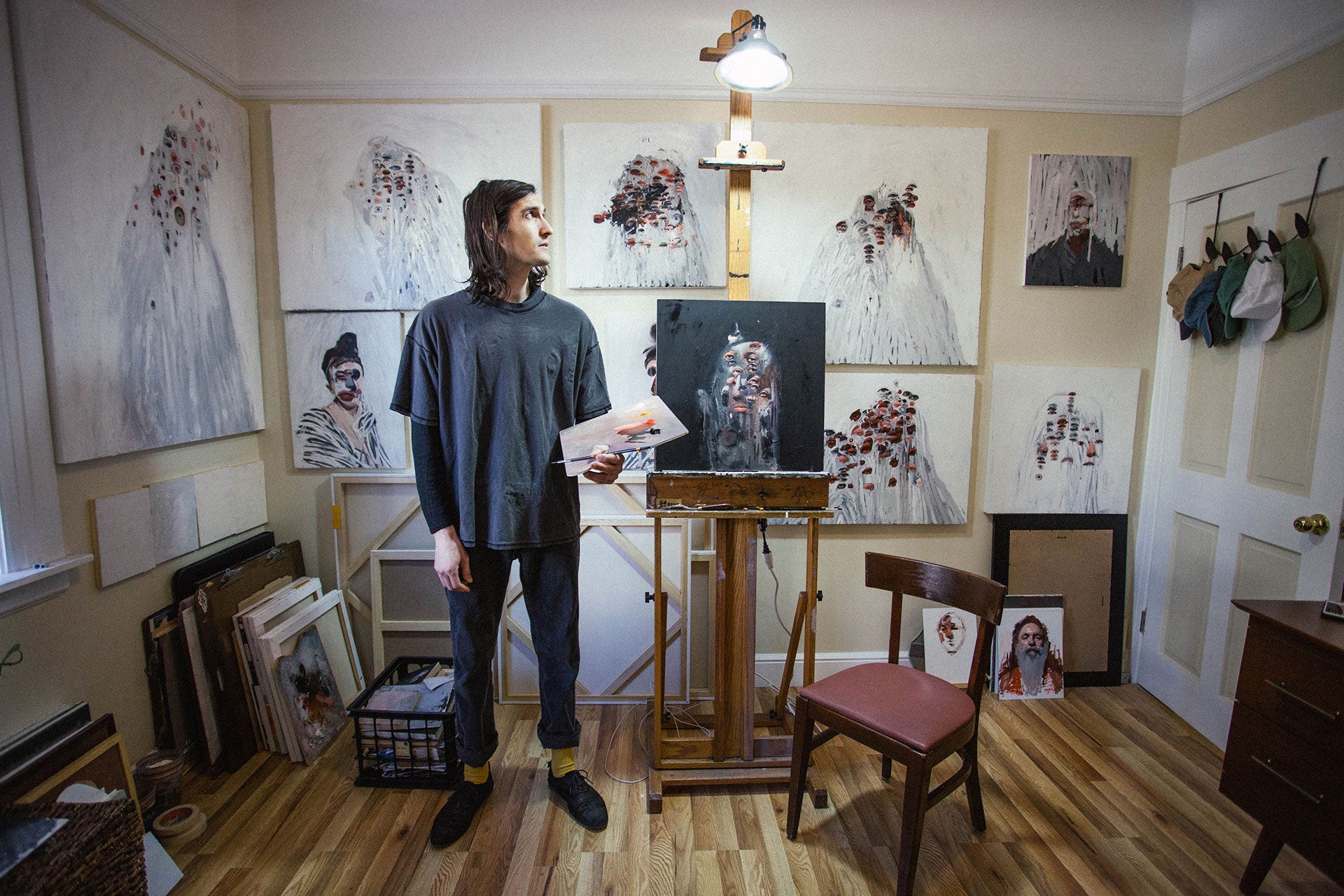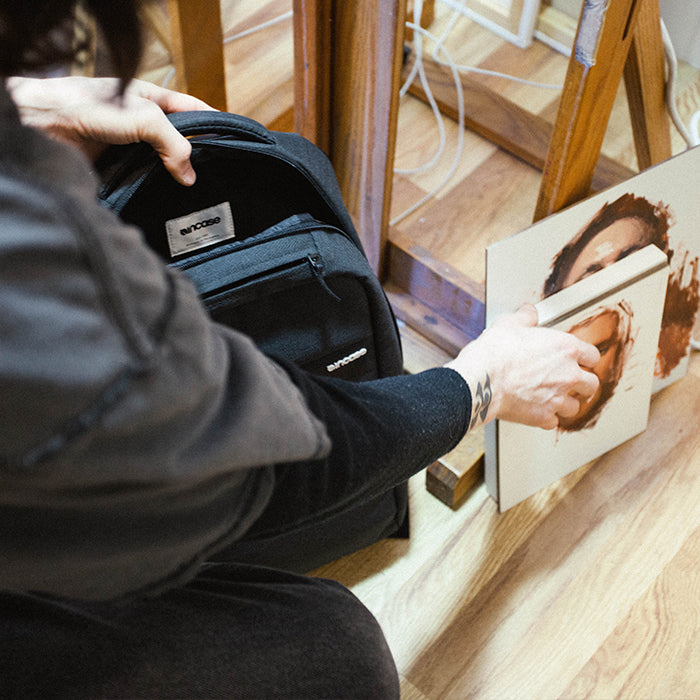Seeing noise and recognizing perspective.
Noise is defined as a loud, confused or senseless outcry. Any sound that is undesired or interferes with one’s hearing of something. But Emilio Villalba doesn’t hear noise—he sees it. He’s inspired by it. He paints it. Villalba allows noise to shed its traditional, uncontained rationale, exploring its visual dimension with textures, colors, angles and negative space in a contained canvas medium. The result is a dissonant one—a peculiar, yet abrupt, reflection that details the distortion and impact of extraneous forces in day-to-day reality. In other words: a loud, confused and senseless perspective of the human condition.

In Villalba’s daily routine, external force acts as a creative stoke continually feeding and influencing his work. Always motivated by the likes of masters Goya, Manet, Picasso and Velázquez, he finds now that his “influences are in transition” from exposure to “many different cultures coexisting” where he resides in San Francisco. He immerses himself in the rich diversity of the Mission District, where he hosts workshops and instructs collegiate-level fine art. Villalba affirms that working so closely with the next generation of artists is more than just a job—it’s a lifestyle. He loves “sharing as much as [he] can to help others achieve their goals”. Whether he’s lugging his gear around to different classes and workshops with his TRACTO Roller Duffel, inspiring the young minds of tomorrow, or using social media to engage and interact, Villalba lives in synchronicity with his art—growing, learning and always offering a different vantage point of reality. Read the full interview below.

"I’ve always seen my work relatively abstract in comparison to most figurative artists, especially the ones I went to school with. I started as an abstract major, and from the very beginning, I learned I liked noise, but not just any noise—contained noise."
Q: What is the story behind your first painting? What was it, and what served as your inspiration?
Emilio: I’ve been painting off and on for about 10 years, but for the last three, I have consistently painted without many breaks. The first paintings acted merely as a warm-up to get the ideas flowing. When I painted my first “distorted” portrait, there wasn’t necessarily a concept for what the image should look like, but rather a process. I’d paint a portrait in black and white, redraw the same portrait from a different perspective on top, then paint that layer in color. I’d stop about halfway through the color step of the painting and call it finished. I enjoyed the mystery of the incomplete, and the black-and-white layer complemented the color well.
Q: Your paintings are laden with dissonance by distortion. Can you detail the evolution of this perspective from its origin to present?
Emilio: I’ve always seen my work relatively abstract in comparison to most figurative artists, especially the ones I went to school with. I started as an abstract major, and from the very beginning, I learned I liked noise; but not just any noise—contained noise. In this case, the portrait becomes the noise where I can experiment and play around with placement of eyes and features, as well as other elements of design—color, shape, etc. Then, on the outside, the background would be flat. For me, the challenge is finding balance on the canvas between the noise and the flat in a pleasing way for myself. What I find pleasing to look at changes every week [Emilio laughs]
Q: Tell us about your progression as an artist. In what direction is it headed?
Emilio: For me, painting is a lifestyle, so I’m always thinking about paintings and imagining rhythms and colors for future pieces, but it’s hard to say where it’ll end up. Right now, I’ve been thinking about moving into a fuller figurative direction. Painting the nude is very classical—a traditional direction that I’ve never really explored. Recently, I had two nightmares that have sparked a direction for the work. I’ve started some sketches on paper, but we’ll see if they end up on canvas.
[carousel]








Q: Who inspires your work now, and how does living in San Francisco play a role?
Emilio: At the moment, I think my influences are in transition. I’ll always have my main heroes, like Velázquez, Goya, Picasso, and Manet (etc.), but I’m discovering new direction everywhere. I’m very easily influenced and can immerse myself in a genre and be sucked right up. Living in San Francisco is amazing for that. I love my neighborhood (the Mission District), and it’s a perfect example of so many different cultures coexisting in a small area. My recent body of work was initially inspired by the neighborhood and its rich diversity.
Q: You teach fine art at the collegiate level, as well as several painting workshops. What does leading and inspiring the next generation of artists mean to you?
Emilio: I love teaching, and hopefully I can teach for the rest of my life. I still feel like a student myself, and I’m constantly teaching what I have just learned to my students. I have no secret methods or techniques and love sharing as much as a I can to help others achieve their goals. Like I said earlier, painting for me is a lifestyle—it’s more about being in the moment and creating, rather than being solely picture oriented. I love meeting other artists capable of sitting in front of a canvas for hours without distraction.
Q: How do you use social media? What’s your overall point of view on it?
Emilio: Social media has become a platform to showcase my work and to engage with people that show interest in it all over the world. It’s been a huge blessing and I’m so thankful and honored to see people reacting to the work in a positive way. For art, I think social media is amazing. I’m able to follow and connect with artists from all over and see what they are working on immediately without having to wait for a publication or exhibition. It’s made art more accessible to the masses and has become more of a household idea versus before, when most people would have to go out of their way to engage with art.

"I love teaching, and hopefully I can teach for the rest of my life. I still feel like a student myself, and I’m constantly teaching what I have just learned to my students."
Q: How do your shows impact future projects?
Emilio: A show is similar to a music album, there is a concept, theme or direction, and includes some deep cuts as well as some singles. I really like the idea of showcasing a body of work in an intimate space. Seeing my work together like that completes the idea and purpose of art. I am making art for myself, but with the idea that it will be presented as a collection for people. I always think about what I would like to see in a collection—then, try to achieve it.
Q: Do you have an upcoming show? Tell us about its context and overarching message.
Emilio: My upcoming show is on March 31 at Booth Gallery in New York City. I will have around 30 pieces, and it’s titled ‘No One’. The concept loosely revolves around the idea of the self in context to all the other “selves” out there. A community of eyes to create one emotion. The overall characters created are inspired by my day-to-day experiences and emotions living in San Francisco, specifically the Mission District. There is a lot going on here, with so many different lives leading different directions, all contributing to the character of the neighborhood.

"Social media is amazing. I’m able to follow and connect with artists from all over and see what they are working on immediately without having to wait for a publication or exhibition. It’s made art more accessible to the masses…"
Q: Are there any other projects you’re involved in?
Emilio: I recently designed a series of paintings for the album design for Mint Field, a band from Tijuana, Mexico. The album “Pasar de las Luces” is out late February, and the music is absolutely stunning! They are a proper shoegaze band with influence taken from bands like Neu! and Pink Floyd. They have a minimal design approach to the work, and they really focus on the textures and rise and fall of the songs. The album is very beautiful, and I’m so grateful that I was asked to be a part of it.
Q: How does your Incase equipment play a role in your work? What is your favorite item?
Emilio: The Incase gear immediately elevated my technology game, which was terrible to non-existent before. The TRACTO Roller Duffel is my favorite piece of equipment that I own at the moment. I love how I can stuff all of my art supplies and clothes in one when I travel to teach a workshop. It looks sleek, and I feel comfortable showing up to each workshop with it, instead of trying to hide my luggage. It’s definitely clutch.
Like what you see?
See more of Emilio Villalba on Instagram at @emilio_villalba or online at emiliovillalbaart.com
See more of photographer Jose Aguirre on Instagram at @_joe_aguirre_ or online at http://www.joeaguirrephotography.com
Shop the story...
https://incase.com/collections/shop-emilio-villalba

